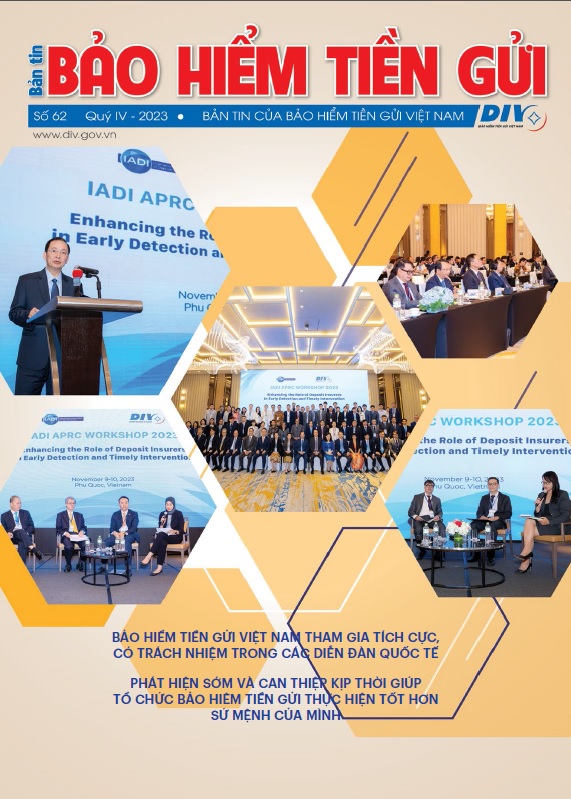Deposit insurance premiums are the largest source of revenue in building up capital to help improve the financial capacity of DIV to pay depositors when payment obligations arise and participate in restructuring credit institutions under the direction of the State Bank of Vietnam (SBV). In order to ensure a smooth and stable premium collection operation, to maintain the correct, sufficient and timely collection target, in addition to well complying with the provisions of law and the direction of the SBV, the DIV always tries to create favorable conditions for insured institutions during the calculation and payment of deposit insurance premium.
As stipulated by the law, insured institutions must pay deposit insurance premiums no later than the 20th day of the first month of the collection quarter. Thus, every quarter, DIV has only 20 days to collect premiums from all insured institutions (1,283 institutions) across the country. In order to perform this task well, the DIV has built an effective deposit insurance premium collection system, reflected in a simple process, quick procedures, close and accurate monitoring, and thoughtful instructions to facilitate favorable conditions for insured institutions to cooperate in implementation as follows:
The regulations and instructions are complete, detailed, and clear
To ensure the smooth and timely collection of premiums, from the beginning, the DIV has developed detailed and clear regulations and guidelines that make it easy for insured institutions to understand and implement. In these documents, the DIV clearly states the rights and responsibilities of the parties, clearly instructs the types of insured/uninsured deposits, the method of premium calculation, the form of reporting, payment of premiums, the handling penalties for violations… These contents are presented scientifically, clearly, and transparently, creating favorable conditions for insured institutions to consistently implement throughout the system.
Guide and support insured institutions in calculating and paying deposit insurance premiums
For the collection of premiums to be effective, the DIV has guided and supported the staff who directly calculate the deposit insurance premiums at the insured institutions about new regulations or guidelines on deposit insurance premiums, ensuring that they fully understand the rules to do the job effectively. In addition, DIV regularly provides guidance and support on the way to implement, processes and procedures for the staff of the insured institutions when problems arise, helping the insured institutions handle quickly, ensuring that the deposit insurance premium collection activities take place smoothly for many years.
Arrange the management by types and locations
Currently, the there are 1,283 insured institutions nationwide, including 97 banks and foreign bank branches, 1,181 people's credit funds, 1 cooperative bank and 4 microfinance institutions. It can be seen that the number of insured institutions is quite large, in which the People's Credit Fund accounts for the largest proportion. Therefore, DIV has managed the decentralization of deposit insurance premium collection to the regional branches according to the distribution of the insured institutions. After that, the branches continued to assign staff to manage the collection from insured institutions in each locality. Such decentralization of management makes it convenient for the DIV to monitor and understand the operating situation, understand the specifics of each locality as well as each organization, from which it can properly urge, guide, and support more closely in the collection of deposit insurance premiums. This helps the collection of deposit insurance premiums be done quickly, conveniently and with high efficiency.
Provide and respond quickly and conveniently
Normally, insured institutions are required to provide information to pay deposit insurance premiums to DIV periodically before the 15th day of the first month of the collecting quarter. Because the time to prepare and send information and reports is very short, it is extremely important to support insured institutions to provide information accurately and in a timely manner. This content is reflected in the following points:
Concise and useful information
The content of information and reports for deposit insurance premium payment is shown in tables 02a/BHTG and 02c/BHTG (for units paying periodic premiums) or 02b/BHTG (for special cases). In addition to the above tables, insured institutions are not required to submit any other types of reports except for particular requirements. In special cases where they are placed under special control and are exempted from paying premiums, the insured institutions only need to submit additional decisions on special control (decision on placing special control, decision on extension of special control, decision on ending special contro) as a basis for premium waiver and such documents usually only need to be submitted once until a new decision is made. The forms and information provided to DIV for payment of deposit insurance premiums are scientifically designed and concise, enabling insured institutions to prepare and submit complete, accurate and timely information.
The way to send/receive information is quick
Currently, DIV has developed a technology system to assist insured institutions in providing information. This system helps the exchange and sharing of two-way information between the DIV and the insured institutions quickly and conveniently. In addition, the system also supports technical inspection of reporting criteria to detect and list errors (if any) and immediately respond to the insured institutions to check, clarify and send information back. This process takes place automatically, reducing effort and time, but still ensuring objectivity and easy checking of information for both the DIV and the insured institutions. This electronic information provision and feedback will create the premise for further steps, such as fully electronic premium collection, creating more convenience for insured institutions.
The actual implementation of deposit insurance premium collection over the past time shows that the payment by bank transfer is growing more and more. This is completely consistent with the non-cash policy of the SBV. The deposit insurance premium transfer method has been well developed and supported by banks. The main advantages of this form is that it is fast, accurate, easy to look up, requires no travel time, has a simple implementation process… Therefore, DIV encourages the payment of premium by bank transfer and limits the payment of premiu in cash. In fact, this activity has been implemented by DIV for a long time and achieved high efficiency, ensuring timely premium collection.
Insured institutions are encouraged to pay fees by bank transfer
The actual implementation of deposit insurance fee collection over the past time shows that the payment/remittance by bank transfer is growing. This is completely consistent with the non-cash policy of the State Bank. The deposit insurance fee transfer method has been well developed and supported by banks. The main advantages of this form are very clear such as fast, accurate, easy to look up, no travel time, simple implementation process... Therefore, DISs encourage the payment of fees by bank transfer. and limit the payment of fees in cash. In fact, this activity has been implemented by the Deposit Insurance for a long time and achieved high efficiency, ensuring timely and timely collection of fees.
Flexible in handling over/under deposit insurance premiums with small amounts
The collection of deposit insurance premium always generates cases that need to be handled such as over-collecting, under-collecting or paying a deposit insurance penalty. Therefore, DIV regulates that it is possible to offset the excess fee or pay an additional fee in the next deposit insurance premium collection period. This helps to reduce procedures and steps for both parties while ensuring effective collection of deposit insurance premiums. During the implementation process, this work has received positive responses, reflecting in the very good compliance of the insured institutions.
Premium notification
In addition to sending notices when there is an excess, deficiency or delay of deposit insurance premiums quarterly for the parties to jointly handle, periodically at the end of the year, DIV will also send to the insured institutions a notice of premium, summarizing the amount of deposit insurance premium already paid during the year. This is done so that both parties can check the amount of premium paid for the whole year, in order to limit the case of overpayment/underpayment or confusions and errors (if any) so as to come up with a settlement plan as soon as possible. This contributes to ensuring a transparent, smooth and stable collection of deposit insurance premiums, maintaining the target of correct, sufficient and timely collection.
Developing policy on deposit insurance premium
Experiencing the practical implementation of deposit insurance premium collection, DIV has made recommendations to change and supplement policy on deposit insurance premium to be more consistent with reality, to better support deposit insurers. Typically, the Deposit Insurance of Vietnam is studying to propose the promulgation of regulations allowing for the exemption, reduction and extension of deposit insurance premiums for force majeure cases such as natural disasters and epidemics, which are highly practical for the purpose of better supporting insured institutions when they are in difficult circumstances due to force majeure factors. In addition, the DIV will continue to do research and develop other contents aimed at the convenience of the deposit insurance premium calculation and payment by insured institutions.
It can be said that collecting deposit insurance premium is one of the important tasks of the DIV. In order to perform this task well, the DIV always aims at the convenience of all stakeholders, especially the insured institutions. This is reflected from the regulations, processes, procedures, application of technology to the proposal to develop a policy on deposit insurance premium. These activities are directed towards the common task of protecting the legitimate rights and interests of depositors, contributing to maintaining the stability of the credit institution system, and ensuring the safe and healthy development of banking operations.



























